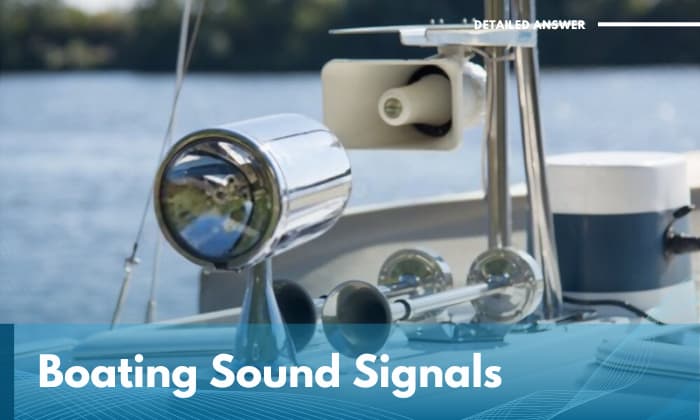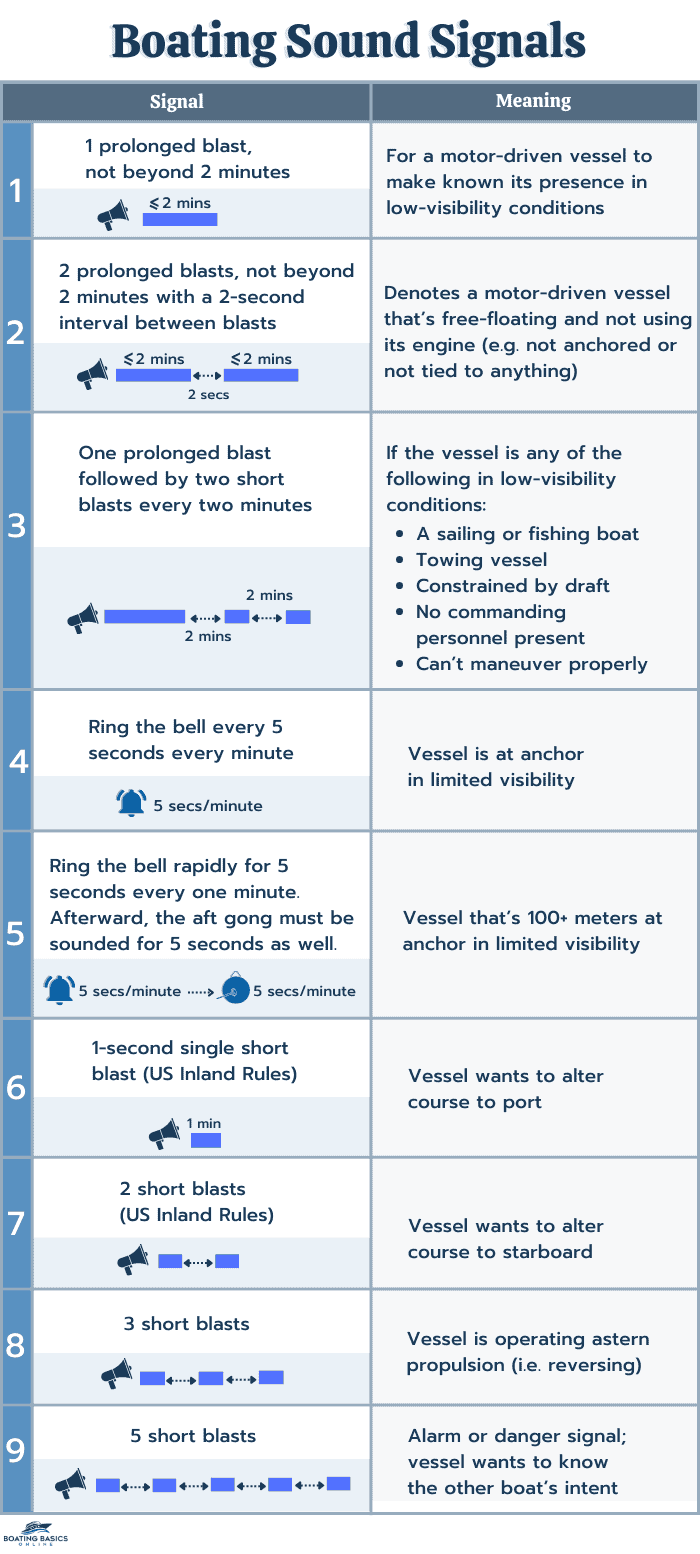While boating sound signals are rarely used in everyday boating, it does pay to know them. They prove to be especially useful once the fog gets too thick, for example, or in any other scenario wherein visual signals aren’t as effective.
Sound signals for boats can be produced either by horns or bells and depend on factors such as the vessel’s type, whether it’s power-driven, its current state and position, and possible danger. The said factors determine how these sound signals should be used.
Continue reading to know every pertinent detail about maritime sound signals.
| Signal | Meaning |
| 1 prolonged blast, not beyond 2 minutes | For a motor-driven vessel to make known its presence in low-visibility conditions |
| 2 prolonged blasts, not beyond 2 minutes with a 2-second interval between blasts | Denotes a motor-driven vessel that’s free-floating and not using its engine (e.g. not anchored or not tied to anything) |
| One prolonged blast followed by two short blasts every two minutes | If the vessel is any of the following in low-visibility conditions:
|
| Ring the bell every 5 seconds every minute | Vessel is at anchor in limited visibility |
| Ring the bell rapidly for 5 seconds every one minute. Afterward, the aft gong must be sounded for 5 seconds as well. | Vessel that’s 100+ meters at anchor in limited visibility |
| 1-second single short blast (US Inland Rules) | Vessel wants to alter course to port |
| 2 short blasts (US Inland Rules) | Vessel wants to alter course to starboard |
| 3 short blasts | Vessel is operating astern propulsion (i.e. reversing) |
| 5 short blasts | Alarm or danger signal; vessel wants to know the other boat’s intent |
Table of Contents
Boating Audio Signals
Horn signals for boats are pretty straightforward, and the table above proves as much. Now that you know about them, it now falls in your hands to use them properly and respond appropriately if another vessel happens to send them to you.
I want to make it clear that I prioritized the American inland rules and meanings of the sounds since that’s where I reside. Do take note that inland and international rules overlap in some of their signals and respective meanings as well.
If you happen to plan to boat in another country, like let’s say England, know that there are other shipping horn signals that they use. Consider visiting this site to know about those other signals: https://eoceanic.com/sailing/tips/27/269/getting_to_grips_with_sound_signals/
Now that we’ve touched on the topic of maritime rules abroad, it’s only right to tackle the confusion that arises sometimes when it comes to inland rules in the US compared to international ones.
For example, in international rules, the respective meanings for 1 short blast and two short blasts are reversed. Moreover, some boaters believe that three short blasts are the right signal to give when going astern, but to others, it’s actually prolonged.
I hope that with the above marine sound signals chart centering solely on US rules, you’ll be able to get a clearer, more reliable reference as an American boat owner or aspiring skipper.
List of Sound Signals for Boat
- One short blast
- Two short blasts
- Three long blasts on ships horn
- Five short blasts
- 1 long 2 short blasts every two minutes
- One prolonged blast every two minutes
- Two prolonged blasts every two minutes with an interval of two seconds
- Ring bell every 5 seconds in 1 minute; ring gong at the aft for 5 seconds
What Do Sound Signals for Boat Mean?
As can be readily construed from the table I shared above, the ship whistle signals and marine horn signals a watercraft sends can mean any of the following intentions listed in the right column. Feel free to return to the table if you get confused about any of the respective meanings of the bells and boating horn signals.
Frequently Asked Questions
What are the legal requirements for sound signals for boat?
Boats that span less than 39 feet should carry a single horn or bell. Those that reach 40 feet to 65 feet should have two appropriate sound-signaling tools, namely a bell and whistle. The tools should be audible within almost 1 km.
When do you make sound signals on your boat?
Boat horn sounds as well as bell and gong ones should only be created to communicate to nearby vessels your intent, the boat’s current state, your position, and how far you are. In short, only make these sounds if a specific maritime scenario calls for them.
Conclusion
The numerous boating sound signals we’ve discussed here, as well as the variations that they have depending on where you’re sailing, proves there’s a solid system in place to keep sailors and ships safe. Overall, using sound signals isn’t the norm, especially if boaters are just navigating the waterways.
However, we can’t deny that their value doubly increases during an emergency, and if you’ve spent enough time sailing, you’ll agree that adopting a “better safe than sorry” attitude goes a long way. Remembering these signals is a good step in that direction.

“My intention from the first day establishing Boating Basics Online is to provide as much help as possible for boaters who want to experience a first safe and convenient trip. So feel free to join us and share your beautiful journeys to the sea!”




